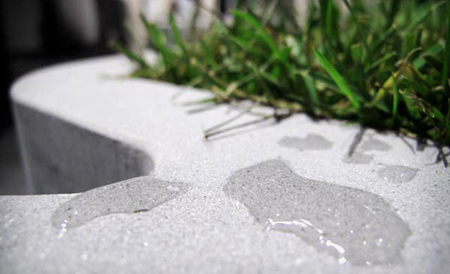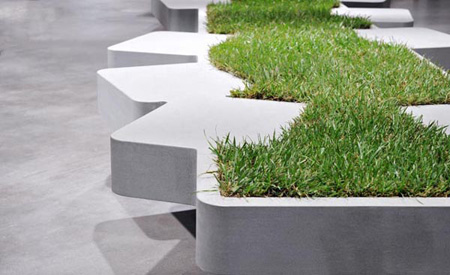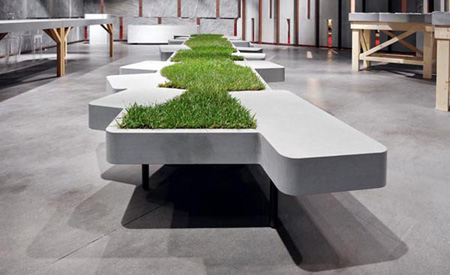4 Febbraio 2010
English
Grass bench

Grass, stone, and water: details of the Grass Bench, designed by Philippe Nigro for Pibamarmi. (ph. Giovanni De Sandre)
«Around Mister Palomar’s house, there’s a lawn. This is not a place where usually there would be a lawn; so the lawn is an artificial object, made of natural objects, that is to say grass. The lawn has, in a way, the aim to represent nature, and this representation happens substituting proper nature with a sort of nature that is natural in itself but artificial in relationship with that place. […] The lawn is made of dicondra, ryegrass, and clover. This is the melange that was spread, in equal parts, on the ground at the moment of the seeding. The dicondra, little and wiggling, has soon took the upper hand: its carpet of little, round and soft leaves spreads, comfortable to the touch and the sight. But the width of the lawn is given by the sharp lances of the ryegrass, if they’re not too sparse and if they aren’t let grow too much without cutting them properly. The clover grows irregularly, here two locks, there an ocean of them […].
The lawn, in order to have a deign look, has to be a homogenous green sprawl: unnatural result that the natural lawns reach naturally. Mister Palomar is weeding out nestled on the lawn. A dandelion adheres to the ground with a base of toothed leaves, densely overlapped; if you draw the stalk, this remains in your hand while the roots remain deep-rooted in the ground. […] When you star to eradicate the weed, immediately you have to sprout up another one next to it, and another one, and another. Briefly, that spot of grass carpet, which seemed to need only some adjustments, becomes a lawless jungle”.


Dettaglio della panca Grass Bench, disegnata da Philippe Nigro per Pibamarmi. (ph. Giovanni De Sandre)
[photogallery]grass_bench_album[/photogallery]
Mister Palomar’s lawn gives us the idea of a multiform and complex nature modified by men, natural and artificial at the same time, protagonist of our every-day life as the theatre of the eternal struggle between rules and extravagancies, opposite realities that dispute the control on vital forces in continuous regeneration. Now more than ever the basic rules of biosphere and human cultural schemes are, sometimes dramatically, in a dialectic relationship, and our need to regain closeness and confidence with nature becomes more and more urgent. This need becomes clear also in the development of a design which tries to catch vital presences of the vegetal reign, and to overlap and set them in every-day objects or furnishing elements, continuing the ancient relationship between mankind and nature, constituted by affiliation, complicity, and control.
The big Grass Bench is an element thought to bring a piece of nature – i.e. a representation of nature, with an apparent order but actually chaotic and restless – in urban spaces, or inside contemporary living spaces. The seat, recently designed by Philippe Nigro for Pibamarmi and exposed in the Monocromo space at the upcoming MADE Expo, offers itself to the fruition as a stone-limited tray containing a grass sod that can be looked at, touched, mowed; or on which one can walk or lay.
The stone is blue-gray, smooth, silk-like at the touch, unanimated; the grass has a homogeneous green colour, is compact and with a constant width… but above all is alive, and we know – with Palomar – that, if let grow, the lawn of the Grass Bench will expand limited only by the stone borders, loosing the initial homogeneity to eventually become a spontaneous development of aggregated vegetal species.
Go to:
Philippe Nigro
Pibamarmi
